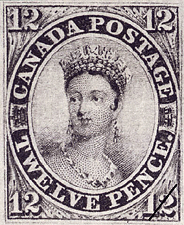The 12 pence (Scott #3) stamp is very similar in design to the 6 pence (Scott #2) denomination but bears the portrait of Queen Victoria rather than Prince Albert. This portrait, used to adorn many early British Colonial stamps, was adapted from a full length painting by Alfred Edward Chalon. The painting was commissioned by the Queen for her mother, the Duchess of Kent, as a souvenir of Queen Victoria's first visit to the
House of Lords and shows her in her robes of state.
The denomination of the stamp requires a few words of explanation. One Shilling being equal to 12 pence, it would appear to be more natural for the stamp to be a shilling issue. However, there were a number of
shillings of different values in circulation in Canada at the time. If the stamp had been lettered ‘One Shilling’, the Post Office would possibly have had to sell it for 6½ pence, 7½ pence, 10 pence or 12 pence, depending on where in Canada it was being used. To avoid this confusion, it was decided to denominate the stamp in pence.
The 12 pence stamp was issued on June 14th, 1851. It was produced on laid paper without perforations. It was withdrawn from use (along with all other pence issues) on July 1st, 1859, when decimal currency was introduced.
Needless to say, the 12 pence value is a very rare stamp. Even if the full supply of 51,000 stamps, received in the first and only consignment from the manufacturer on May 4th, 1851, been issued, it would have been a rare variety, but as a matter of fact, the greater portion of the consignment was destroyed and only 1,510 were actually issued. An interesting article published in the
Metropolitan Philatelist in 1902 shows the supply issued to the various post offices:
|
| No. Stamps |
| June 14th, 1851, | Hamilton, | 300 |
| Oct. 17th, 1851, | Chippewa, | 100 |
| Nov. 13th, 1851, | Thorold, | 20 |
| Nov. 25th, 1851, | Toronto, | 200 |
| Mar. 8th, 1852, | Montreal, | 200 |
| Sept. 14th, 1852, | Ingersoll, | 100 |
| Apr. 5th, 1853, | Ottawa (then known as Bytown), | 100 |
| Oct. 20th, 1853, | Sherbrooke, | 15 |
| Jan. 13th, 1854, | Smith's Falls, | 50 |
| Jan. 20th, 1854, | Ottawa, | 100 |
| Feb. 8th, 1854, | L'Islet, | 15 |
| Feb. 27th, 1854, | Ingersoll, | 20 |
| Mar. 22nd, 1854, | Sault S. Marie, | 25 |
| May 15th, 1854, | Port. du Fort, | 15 |
| Oct. 21st, 1854, | Rowan Mills, | 50 |
| Oct. 26th, 1854, | Melbourne, | 50 |
| Oct. 27th, 1854, | Montreal, | 100 |
| Dec. 4th, 1854, | Smith's Falls, | 50 |
| Total stamps, | 1,510 | | | | |
The space for the 12 pence Victoria issue is one of those destined to remain forever empty in the albums of most collectors. Current Unitrade value for even just a VG used copy is $35,000. When the
"Loch" collection sold in 1999, a very fine unused no-gum example (as seen here) fetched $74,000. However, there is another way to fill this space. Its still not cheap by most collectors' standards (mine included!) but is much less expensive than owning one of the 1,510 copies issued for postage. The answer is plate proofs. These were produced on
India paper and are marked "Specimen" either vertically or diagonally in either red or green ink. The most recent
Vance Auctions sale listed one of these (Scott #3Pi) with an estimate of $2,500 - still not small change but at least not the equivalent of purchasing a luxury automobile!
Whether or not you ever fill the space for Scott #3 in your Canada album, knowing the story of this interesting stamp will add to your collecting pleasure and who knows, maybe one day you'll run across one of these rarities in a musty old album at a garage sale - stranger things have happened!







































